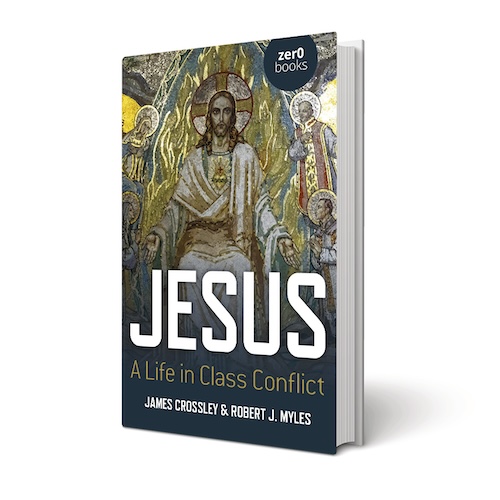Plenty of Marxists have turned to the New Testament and the origins of Christianity. Memorable examples include the works of F.D. Maurice and Zhu Weizhi’s Jesus the Proletarian. After criticizing how so many translations of the New Testament soften Jesus’ teachings regarding material possessions, greed, and wealth, Orthodox theologian David Bentley Hart has gone so far to ask, “Are Christians supposed to be Communists?” In the Huffington Post, Dan Arel has even claimed that “Jesus was clearly a Marxist, not by name, but by ideology.” With a title like Jesus: A Life in Class Conflict, one might assume that this volume, produced by Bible scholars James Crossley and Robert J. Myles, is another disposable piece of popular nonfiction, wedging Jesus into the authors’ political mold. Thankfully, this is not that kind of book.
Was Jesus a proto-Marxist? Some say yes. Others are convinced he did not fit into any neat category, ancient or modern. What’s certain is that of the making of many “historical” biographies there is no end.

By James Crossley and Robert J. Myles
(Zero Books, 2023)
Knowing they will be accused of turning Jesus into a proto-Marxist or forerunner of socialism, Crossley and Myles are quick to say that is not their goal. Their concern is methodological and pragmatic. The purpose of the book is not to read a socialist Jesus into the early Jesus tradition, preserved in the Gospels and the letters of Paul, but rather to examine the social, material, and class conditions that shaped the life of Jesus and his earliest followers. Put another way, what Crossley and Myles have produced is a Marxist reading of the Gospels, not a Marxist gospel.
For too long, claim Crossley and Myles, Bible scholars of various political commitments and confessional creeds have crafted a Jesus in their image—or at least their idealized image. Little wonder that readers can find all sorts of Jesuses to fit their preferences, whether it be a Jesus for evangelical Americans, a Jesus for the nonreligious, or a Jesus for third wave feminists. The authors’ solution to this methodological doom spiral? An approach that emphasizes historical materialism when studying the historical Jesus and the birth of Christianity.
Crossley and Myles begin their history by arguing that Jesus was most likely the eldest son of Mary and Joseph and born in the unremarkable town of Nazareth (not Bethlehem), and at some point in adulthood he felt called by God. From peasant artisan to apocalyptic preacher and millenarian hopeful, Jesus garnered a humble following based on his ability to cast out demons and perform healing miracles. His parabolic message was full of not-so-subtle warnings, criticisms, and invitations to men and women across the Judean political, religious, and class spectrum. As this message garnered followers, he inevitably brought attention to and endangered himself, so much so that he ended up on a Roman cross. Much of the portrait painted by Crossley and Myles will be all too familiar to any with a passing knowledge of the quest for the historical Jesus. Where these authors shine, however, is in illustrating the socio-economic world of Jesus and his first followers.
The authors have produced is a Marxist reading of the Gospels, not a Marxist gospel.
Unlike the peaceful and prosperous image painted by Howard Clark Kee, Crossley and Myles argue that the Galilee at the time of Jesus was dangerous, dislocated, and distressed. Given that Jesus was a craftsman, the authors assert that the rebuilding of Sepphoris and the building of Tiberias would have dramatically displaced people like Jesus. The ancient historian Josephus provides evidence for this economic unrest with numerous references to banditry as well as various tax revolts. With remarkable ease, Crossley and Myles situate readers in the economically desperate, brutally violent, and apocalyptically expectant time and place that produced Jesus and his movement. The hopes, the stakes, and the vulnerability of that movement are made tangible and real.
What follows is a rather standard telling of the life of the historical Jesus, at least standard for anyone with a passing familiarity with the works of N.T. Wright, Bart D. Ehrman, and Paula Fredriksen, all of whom present Jesus as a millennial prophet, with Wright standing out as the sole believing Christian of the trio. Crossley and Myles’ overall profile of Jesus may not be that original, but their insights into the Jesus movement are quite compelling and the best elements of this book. Pointing to Jesus’ inner circle of fishermen and the agricultural basis of so many of Jesus’ parables, the authors emphasize the connections between Jesus’ followers and the Galilean peasantry. Furthermore, the often referenced “crowds” throughout the Gospels in Greco-Roman literature were understood to reference the lower classes. But while most scholarship has focused on Jesus’ ability to heal the sick, cast out demons, and forgive sinners, more important for Crossley and Myles is the disciples’ ability to partake in and utilize this same divine power. Not only will Jesus sit on a throne—so will his closest followers as they join him in judging their pagan overlords (Matt. 19:27–28) and even angels (1 Cor. 6:1–3). All this suggests to Crossley and Myles that the Jesus movement had a far more diversified regime of latent power than other historians have credited.
But in its “mission to the rich,” Jesus and his followers could be equally prophetic and pragmatic. While Jesus’ dining with “sinners and tax collectors” is well known in the Christian tradition, Crossley and Myles argue that these “sinners” included the rich and economic exploiters (or Law breakers) and therefore were able to offer space and means for Jesus and his followers to dine. This reading is consistent with that found in other ancient Jewish literature—for example, 1 Enoch 102:9, “Now I tell you, sinners, you have satiated yourselves with food and drink, robbing and sin, impoverishing people and gaining property.” Of course, given the stories of those reluctant to give up their wealth, such as the rich young man in Matthew 19:16–30, it is more than likely that the Jesus movement’s success in these elite circles was limited. In addition, as suggested by E.P. Sanders, if Jesus had won over more of the economic elite, it is unlikely he would have been executed in the manner he was. Even so, the point stands that Jesus’ kingdom message appealed to a broad spectrum and summoned people from across the ancient world’s harsh class divide.
Jesus operated in a style more akin to the prophets of destruction like Jeremiah.
They also believe that Jesus’ advocation of nonviolence was primarily pragmatic, given the Roman occupation and history of horrific retaliation against any who challenged Roman rule. But rather than being what we conceive of as a nonviolent resister, a Martin Luther King Jr. or a Mahatma Gandhi, Jesus operated in a style more akin to the prophets of destruction like Jeremiah. He may have instructed his followers to “turn the other cheek,” but such advice was designed to help grow and foster the movement, not to be a set of ethics. In the messianic age to come, divine violence would be dealt out on behalf of Jesus’ followers. Caesar’s violence would be replaced by the God of Israel’s violence, a human empire swapped out for a divine empire—but an empire nonetheless.
But God’s empire did not come, and the messianic age never arrived. Jesus’ kingdom movement should have ended with his crucifixion at the hands of the Romans, yet Crossley and Myles do think that the postmortem visions of Jesus were genuine—or at least that they contain a sincere though problematic historical memory from his closest disciples. These visionary experiences, coupled with their messianic expectations, helped launch the Christian faith. Once again, grounding their reading in class analysis, Crossley and Myles take stock of the Jesus movement’s transformation from one originally grounded in rural subjects of the Roman Empire to one centered on the urban elites of that empire. One is reminded of Marx’s often quoted line that “all great world-historic facts and personages appear… the first time as tragedy, the second time as farce.”
Crossley and Myles’ style is approachable and academic-jargon free, yet it still gets bogged down in Marxist shibboleths such as “organizer,” “central committee,” and “politburo.” Another strange translation choice is “Dictatorship of Peasantry” for “the Kingdom of God.” While such terminology might tickle the sort of reader Zero Books primarily appeals to, it’s distracting at best and cringe-worthy at worst. There are also some curiosities. Early on, Crossley and Myles push back against efforts by Christian apologists to present the historical Jesus as “countercultural” to his Jewish world, and they bristle at the term “subversive.” The reason for this is twofold: to avoid “great man of history” tropes and because of the anti-Semitism such efforts have engendered, fostering images of the “Satanic” Pharisees and Christ killers. Nevertheless, Crossley and Myles highlight instances where the Jesus movement does, in fact, challenge the dominate cultural patterns of the ancient Mediterranean world. Jesus, they argue, was offering an alternative way to live. If that’s the case, why is this not countercultural and subversive? Because it challenges more than just traditional Jewish life in Judea? The distinction made by Crossley and Myles doesn’t quite offer a difference when put under scrutiny.
Even so, there is an old-fashioned quality to Jesus: A Life in Class Conflict that many readers will appreciate. Despite being written from a perspective that questions many of the traditions of the Christian faith, it is respectful in its approach, reasonable in most of its assessments, and simply enjoyable to read. Given its accessibility to the non-scholar and price point, Crossley and Myles’ work might make an excellent companion to N.T. Wright’s The Challenge of Jesus, John Dominic Crossan’s Jesus: A Revolutionary Biography, or Paula Fredriksen’s Jesus of Nazareth, King of the Jews, so long as you approach each with eyes wide open to the authors’ presuppositions. And we all have them.




